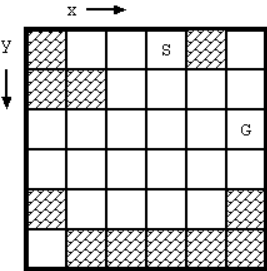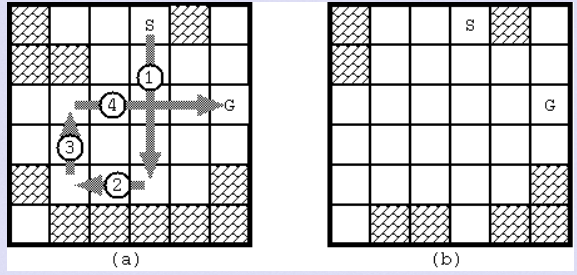G - Curling 2.0
On Planet MM-21, after their Olympic games this year, curling is getting popular. But the rules are somewhat different from ours. The game is played on an ice game board on which a square mesh is marked. They use only a single stone. The purpose of the game is to lead the stone from the start to the goal with the minimum number of moves.
Fig. 1 shows an example of a game board. Some squares may be occupied with blocks. There are two special squares namely the start and the goal, which are not occupied with blocks. (These two squares are distinct.) Once the stone begins to move, it will proceed until it hits a block. In order to bring the stone to the goal, you may have to stop the stone by hitting it against a block, and throw again.
Fig. 1: Example of board (S: start, G: goal)
The movement of the stone obeys the following rules:
- At the beginning, the stone stands still at the start square.
- The movements of the stone are restricted to x and y directions. Diagonal moves are prohibited.
- When the stone stands still, you can make it moving by throwing it. You may throw it to any direction unless it is blocked immediately(Fig. 2(a)).
- Once thrown, the stone keeps moving to the same direction until one of the following occurs:
- The stone hits a block (Fig. 2(b), (c)).
- The stone stops at the square next to the block it hit.
- The block disappears.
- The stone gets out of the board.
- The game ends in failure.
- The stone reaches the goal square.
- The stone stops there and the game ends in success.
- The stone hits a block (Fig. 2(b), (c)).
- You cannot throw the stone more than 10 times in a game. If the stone does not reach the goal in 10 moves, the game ends in failure.
Fig. 2: Stone movements
Under the rules, we would like to know whether the stone at the start can reach the goal and, if yes, the minimum number of moves required.
With the initial configuration shown in Fig. 1, 4 moves are required to bring the stone from the start to the goal. The route is shown in Fig. 3(a). Notice when the stone reaches the goal, the board configuration has changed as in Fig. 3(b).
Fig. 3: The solution for Fig. D-1 and the final board configuration
Input
The input is a sequence of datasets. The end of the input is indicated by a line containing two zeros separated by a space. The number of datasets never exceeds 100.
Each dataset is formatted as follows.
the width(=w) and the height(=h) of the board
First row of the board
...
h-th row of the board
The width and the height of the board satisfy: 2 <= w <= 20, 1 <= h <= 20.
Each line consists of w decimal numbers delimited by a space. The number describes the status of the corresponding square.
0 vacant square 1 block 2 start position 3 goal position
The dataset for Fig. D-1 is as follows:
6 6
1 0 0 2 1 0
1 1 0 0 0 0
0 0 0 0 0 3
0 0 0 0 0 0
1 0 0 0 0 1
0 1 1 1 1 1
Output
For each dataset, print a line having a decimal integer indicating the minimum number of moves along a route from the start to the goal. If there are no such routes, print -1 instead. Each line should not have any character other than this number.
Sample
| Inputcopy | Outputcopy |
|---|---|
|
|
中文:
Descriptions:
今年的奥运会之后,在行星mm-21上冰壶越来越受欢迎。但是规则和我们的有点不同。这个游戏是在一个冰游戏板上玩的,上面有一个正方形网格。他们只用一块石头。游戏的目的是让石子从起点到终点,并且移动的次数最小
图1显示了一个游戏板的例子。一些正方形格子可能被砖块占据。有两个特殊的格子,起始点和目标点,这是不占用块。(这两个方块是不同的)一旦石头开始移动就不会停下,除非它击中砖块块。为了使石头到达终点,你可以通过让石块击中墙壁或者砖块来停下。

图1:例子(S:开始,G:目标)
石头的运动遵循以下规则:
- 开始时,石头静止起点广场上。
- 石头的运动仅限于x和y方向。禁止对角线移动。
- 当石头静止时,你可以让他向任意方向移动,除非它移动的方向上有砖块(图2(a))。
- 一旦抛出,石头不断向同一方向移动,直到下列事件之一发生:
- 石头击中砖块(图2(b),(c))。.
- 石头停在他击中的砖块之前
- 被击中的砖块消失
- 石块飞出游戏板之外。
- 游戏结束的条件
- 到达目标点
- 石头停在目标点游戏成功
- 石头击中砖块(图2(b),(c))。.
- 不能在十步之内到达目标点则返回失败。

Fig. 2: Stone movements
通过这些规则我们想知道,石头是否能够到达目标点和最少移动次数
初始配置如图1所示,石头从开始到目标需要4次移动。路线如图3所示(a)。注意当石头到达目标时,游戏版的配置如图3(b)改变。

图3:图1的解决方案和解决之后的结果。
Input
输入是一组数据。输入结束标志为两个0。数据组的数量不超过100。
每个数据集如下展示
板的宽度(w)和高度(h)
游戏版的第一行
...
游戏版的h-th行
版的宽和高满足: 2 <= w <= 20, 1 <= h <= 20.
每行由一个空格分隔的十进制数字组成。该数字描述相应的格子的状态。
1 砖块
2 开始点
3 目标点
图. D-1数据如下:
6 6
1 0 0 2 1 0
1 1 0 0 0 0
0 0 0 0 0 3
0 0 0 0 0 0
1 0 0 0 0 1
0 1 1 1 1 1
Output
对于每个数据,打印一个十进制整数的行,表示从开始到目标的路径的最小移动次数。如果没有这样的路线,打印- 1。每个行不应该有这个数字以外的任何字符。
Sample Input
2 1 3 2 6 6 1 0 0 2 1 0 1 1 0 0 0 0 0 0 0 0 0 3 0 0 0 0 0 0 1 0 0 0 0 1 0 1 1 1 1 1 6 1 1 1 2 1 1 3 6 1 1 0 2 1 1 3 12 1 2 0 1 1 1 1 1 1 1 1 1 3 13 1 2 0 1 1 1 1 1 1 1 1 1 1 3 0 0
Sample Output
1 4 -1 4 10 -1
题解:
很明显的,dfs搜索,但是方向数组(一开始是一格一格走的现在改为一条一条走(个人觉得好像就是这么一点区别)),然后呢,就是注意一下条件的判断加上回溯和剪枝就行啦!
上代码!!!
#include<iostream>
using namespace std;
int m[30][30];
int w, h;
int ans = 100;
int dx[] = { 1,-1,0,0 };
int dy[] = { 0,0,1,-1 };//方向数组
void dfs(int x, int y,int t)
{
if (m[x][y] == 3)//终点
{
ans = min(t, ans);
return;
}
if (t >= 10 || t >ans)
return;//剪枝,减少没必要的递归
for (int i = 0; i < 4; i++)
{
int x1 = x + dx[i];
int y1 = y + dy[i];
if (m[x1][y1] == 1||x1<1||y1<1||x1>h||y1>w)//不能走的情况
continue;
while (x1 >=1 && x1 <= h&& y1 >=1 && y1 <= w && m[x1][y1] != 1)
{
if (m[x1][y1] == 3)//到终点的情况
{
t++;
ans = min(t, ans);
return;
}
x1 += dx[i];
y1 += dy[i];//没到终点就一直走
}
if (x1<1 || y1<1 || x1>h || y1>w)//出界
continue;
t++;
m[x1][y1] = 0;//撞墙了,墙破
dfs(x1-dx[i], y1-dy[i], t);
t--;
m[x1][y1] = 1;//回溯
}
}
int main()
{
int x = 0;
int y = 0;
for (;;)
{
cin >> w >> h;
if (h == 0 && w == 0)
break;
else
for (int i = 1; i <= h; i++)
{
for (int j = 1; j <= w; j++)
{
cin >> m[i][j];
if (m[i][j] == 2)//起点的位置
{
x = i;
y = j;
}
}
}
dfs(x, y, 0);
if (ans > 10)
ans = -1;
cout << ans << endl;
ans = 100;
for (int i = 1; i <= h; i++)
{
for (int j = 1; j <= w; j++)
m[i][j] = 0;//初始化数组
}
}
return 0;
}最后的最后,祝各位题题ac,比赛ak!